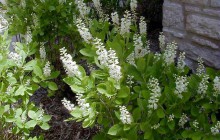Native Landscaping: Designing a Jersey-Friendly Shade Garden
The goal: Plant a woodland shade garden that's diverse, quick to spread, and well-suited to the sandy loam we have here in the Inner Coastal Plain.We don't have all that many full-sun spots in our yard, but the area just behind our house barely gets even the tiniest glimmer of sun throughout the day, so this winter I'll be working on a plan for a fern-heavy woodland understory shade garden. It'll be an experiment, as always. The area doesn't seem to drain quite as well as other parts of our yard, and gets more runoff from the house than others, but I'm not sure if it's wet enough for some of the plants we're considering.Here in Collingswood, we're living in New Jersey's Inner Coastal Plain region. One of the most awesome things about the great Garden State is that it's both one of the smallest and the most ecologically diverse states. And though we typically choose to hike in or travel to regions other than our own, particularly the Pine Barrens within the Outer Coastal Plain, I feel pretty thankful for the nice soil we have here in the Inner Coastal Plain. What I don't feel thankful for: It's super built-out and our little part of the state has done pretty terribly when it comes to preserving the rare plants that once made it special.As I start my search using the JerseyYards.org plant database, I select "Sandy" and "Loam" and "Coastal Plain" region. It doesn't support the level of detail I'm considering just yet, so I'll just have to do a little more research to narrow down my list later. I'm also cross-checking all of the plants I like with the Native Plant Society of New Jersey's Camden County Plants list, just to be extra sure they're well-suited for our region.In order to avoid the common mistake of focusing on just one layer rather than the multi-layer approach that supports a healthy ecosystem, I'm going to look for some larger shrubs, flowers, ferns and groundcover. (Note: All of the descriptions in quotes below come from the JerseyYards.org database.)
Working List of Plants for our Shade Garden:
Summersweet (clethra alnifolia) / Shrub
This will be the most upper layer given the proximity to our house and an existing small tree. I love that it's a great shrub for birds, butterflies, hummingbirds and bees, but I am a little concerned that it won't be quite wet enough for it to thrive. Tim collected a few seeds on a hike earlier this fall, but we may want to get a jump start by buying a plant that's a year or more old."Summersweet is a multi-branched deciduous shrub with dark green, aromatic leaves. It is one of the few summer-flowering shrubs that will bloom in shade. The sweetly fragrant, white flowers bloom in upright clusters on the tips of stems, July-August."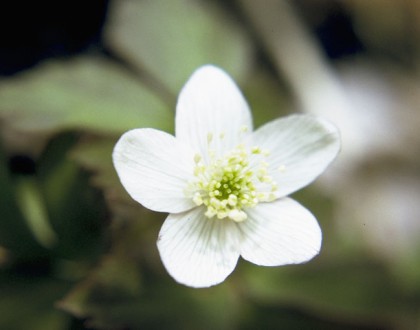
Wood Anemone, Wood Windflower (Anemone quinquefolia) / Groundcover
This one is a little bit of a risk, because I'm not quite sure whether it's wet enough in the area. It's beautiful, though."Wood Anemone is a delicate, early-spring perennial. It features a whorl of deeply-cut, dark green leaves and a solitary white flower that blooms atop a 4 to 8-inch stalk, April-May. The graceful movement of the slender flower stalks in the wind led to its other common name, Wind Flower. Wood Anemone is a spring ephemeral ? the plants die back in mid-summer. This plant forms colonies and makes a good spring groundcover for shady areas."
Strawberry Bush (Euonymus americanus)
Before I go any further, let me just tell you that the common names for this one are strawberry bush, bursting-heart, hearts-a-bustin and hearts-bustin'-with-love. Being able to tell people, "Oh that's a 'hearts-a-bustin'" is reason enough to plant this pretty shrub. Another reason: It seems well-suited for the part of our shade garden that gets a little bit more sun. To find this one, I used the Lady Bird Johnson Wildflower Center's plant finder, filtering for? the following characteristics: New Jersey, Shade and Part Shade, 3-12 feet, Perennial, Shrub. In other words, I'm looking for something for that woody understory layer. 
Eastern Hay-Scented Fern (Dennstaedtia punctilobula) / Fern (Obviously)
This is the main groundcover that surrounds Tim's parents' house in the Poconos (it thrives there, because deer won't eat it. It's simple and beautiful. We brought one home and it's been doing well in this area, so we'd love to plant more next year."Eastern Hayscented Fern is a deciduous fern with light-green, finely textured, lacy fronds. The fronds can be cut for use in flower arrangements. When crushed or dried, the fronds release a fragrance like freshly-mowed hay, inspiring its common name. This plant prefers moist, acidic, organically rich soils." (Read: Add compost!)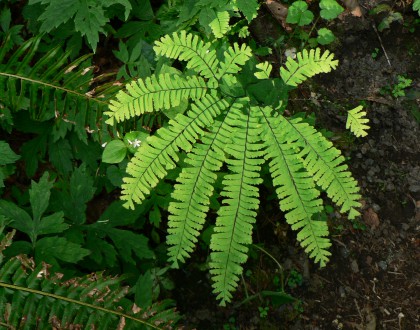
Northern Maidenhair (Adiantum pedatum) / Fern and Groundcover
I'm looking forward to planting several different ferns, because observing them in our own yard will make it easier for me to identify them in the wild. I'm just not a see it once in a book and remember it always kind of learner. I can't wait to observe as they begin emerging and then unfurling: As I've written before, appreciating the differentiating details and the way light hits certain parts of the yard is a worthy endeavor for sure."Northern Maidenhair is a fine-textured deciduous fern. Pink fiddleheads emerge in spring, turning green as they mature. Northern Maidenhair is a good plant for moist, shady sites. This attractive fern combines well with other perennials in shade, woodland, or rock gardens, and makes an excellent edging plant along shady pathways."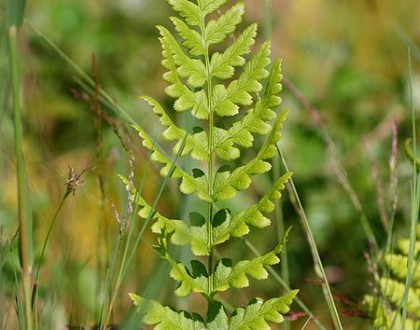
Crested Woodfern (Dryopteris cristata) / Fern
Isn't this one cool? Again, I hope that this area of our backyard is indeed wet enough for a fern like this. It's a risk, but as long as we have some rain and I help the soil out a bit with some compost, I have faith that it'll do well. I might just start with one to see how it does before investing in more."Crested Woodfern is an evergreen fern. The tall, fertile fronds die back in the winter, but the infertile fronds stay green throughout the winter months."
Cinnamon fern (Osmunda cinnamomea) / Fern
This fern is great for adding color to your woodland garden. We picked up a couple of them for my dad, who remembers planting them in the house we were in when my brothers and I were very young. Fingers crossed that they do as well in his yard as ours!"Cinnamon Fern is a clumping deciduous fern. The fronds emerge as fiddleheads. Birds use the ?fuzz? covering the fiddleheads as nesting material. Green, sterile fronds bend outward, encircling fertile, erect, spore-bearing fronds, which quickly turn chestnut-brown, giving this plant its common name."
Sweet fern (Polystichum acrostichoides) / Fern
We first saw and smelled sweet fern while visiting Clemenson Farms, and I fell in love. It smells so great and looks cool too. This one does better with a bit of sun, so I think it'll work in the area that comes closest to the back steps that lead to our kitchen. I'm going to take more time to observe the area where this garden will go to determine whether that's the best place for it. If not, I'll try it somewhere else in the yard."Sweet Fern is not a fern, but a multi-branched, mounded shrub with dark green, aromatic, fern-like leaves. Its inconspicuous, yellow-green catkins (elongated, drooping clusters of tiny flowers without petals) appear April-May, followed by small, burr-like nutlets. It is a host plant for butterfly and moth larvae (caterpillars), including Gray Hairstreak (Strymon melinus)." 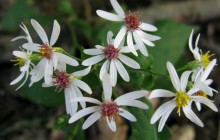
White Wood Aster, Eurybia divaricata / Flower
Because I'd like to mix in some flowers too, for the beauty and for the butterflies: "White Wood Aster has small, daisy-like flowers with white petals and yellow to red centers; it blooms August-September. The flowers are a nectar source for butterflies. This plant tolerates dry, shady conditions. Plant in masses in shady borders or wildflower gardens, or as an understory planting in woodland gardens." Save
